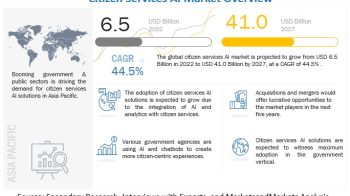The geospatial analytics market size is estimated to be USD 40.65 billion in 2018 and is projected to reach USD 86.32 billion by 2023, at a CAGR of 16.3% during the forecast period. The increasing penetration of Internet of Things (IoT), integration of geospatial technology with mainstream technologies, and advancements in geospatial analytics with the introduction of artificial intelligence and big data analytics are the factors contributing to the growth of the geospatial analytics market.
The global geospatial analytics market has been segmented by component, type, application, vertical, and region. The component segment includes software & solutions and services. The type segment includes surface & field analytics, network & location analytics, geovisualization, and others (geocomputation, agent-based modeling, artificial neural networks, evolutionary computing, map generalization, map abstraction, digital terrain analysis, map sheet). The application segment covers surveying, medicine & public safety, disaster risk reduction & management, climate change adaption, and others. The vertical segment covers business, automotive, utility & communication, government, defense & intelligence, natural resources, and others (sports, logistics, education, tourism, media & entertainment, travel and logistics. agriculture). The regions covered include North America, Europe, Asia Pacific, Middle East & Africa, and Latin America.
Based on component, the software & solutions segment is expected to hold a larger market share in 2018. The adoption of geospatial software & solutions by enterprises is primarily to acquire location-based business intelligence for informed decision-making.
The geospatial analytics market in the Asia Pacific region is projected to grow at the highest CAGR during the forecast period. The demand for geospatial data and services in the region is increasing at a high pace majorly due to the vigorous initiatives taken by the governments to bridge the gap between the prevailing digital technologies and the geospatial technologies. Another driving factor for the Asia Pacific market is the increasing penetration of mobile devices, which is enabling businesses to incorporate geospatial analytics solutions to utilize location-based data generated by such devices.
Various location-based services used in web and mobile-based applications and advanced imagery & sensor solutions have significant growth opportunity in the geospatial analytics market. Numerous location-aware systems and technologies have been incorporated in navigation systems to increase their reliability and intelligence to ensure smooth operation of transportation networks. This also enables development of different applications and systems that utilize location as an attribute to perform operations in different verticals. Thus, the increasing use of location-based services in different verticals across the globe acts as an opportunity for the growth of the geospatial analytics market.
![[Latest 2028] Cloud Security Market Estimation, Key Players, Growth Opportunities](https://mnmblog.org/wp-content/uploads/2024/04/cust-350x196.webp)

